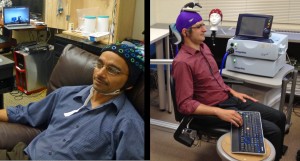A recent experiment has revealed the ability to control another person’s movements remotely using a non-invasive brain-to-brain interface and the internet.
The discovery of electrical activity in the human brain and the introduction of the internet opened up a field of research testing whether it is possible to connect our brains together and to machines in the same way machines speak to each other.
Turns out, it is possible.
In response, a slew of thought-controlled machines have been revealed in the past few years; helicopters, electric wheelchairs and even video games. This week, researchers have discovered it is possible to control another person’s movements simply by thinking about it.
Researchers at the University of Washington were able to connect two humans together in such a way as to allow the Controller to move the Subjects hands in response to stimuli in the room. In the example, the Controller responded to a video game with his thoughts, transmitting his desired movements to the Subject’s brain, causing the subjects fingers to respond and effectively play the game without even seeing it. One person acted as the eyes, the other person acted as the fingers.
Rajesh Rao, one of the researchers, is a professor who has conducted brain to computer interfacing research for the past 10 years. He teamed up with Andrea Stucco, a psychology professor, to demonstrate the possibility of brain-to-brain interaction through the internet. A team of programmers wrote the code that translates the signals received from the Controller’s brain to the Subjects’. Their next project focus on more complicated.
The brain-to-brain interface is completely non-invasive, meaning surgery or connection into the body is not required. A transcranial magnetic stimulation coil is placed around the subjects head, positioned in the area of the brain responsible for controlling the part of the body needing to be moved. An electroencephalography machine – it reads electric activity in the brain – picks up the controller’s thoughts and transmits them through the internet to the subject. Both technologies are familiar to the neuroscience industry, the electroencephalography machine being used on a regular basis to record brain activity while sleeping.
As first glance, the technology brings to mind all sorts of science-fiction horror stories but the researchers insist it shouldn’t be overestimated. The instruments operate only in a very small sphere of control and while it may sound like thought control it isn’t. There is no way for the subject to ever be manipulated or forced against his or her will to respond to the movements. Rather the prompting is like an electric impulse causing a mostly involuntary motion. And the signals being sent are elementary. Reading each other’s thoughts is, for now, not possible…
…but who’s to say it won’t be soon?



